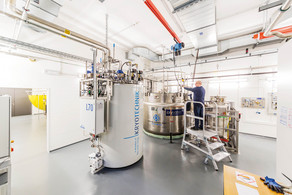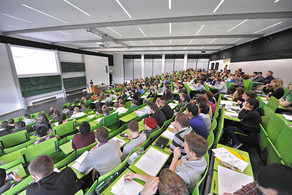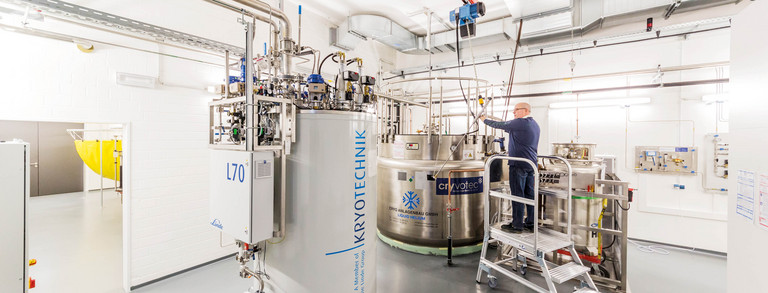Coordinated Programs
The Department of Physics is involved in a large number of coordinated research programs. It is also the coordinator for some of these programs.
Programs coordinated by TU Dortmund University
TRR 160 is the first German-Russian Collaborative Research Center funded since 2015 by the Russian Foundation for Basic Research and the German Research Foundation with a 12-year perspective. Scientists from the Ioffe Institute and St. Petersburg State University as well as TU Dortmund University are involved, working together on coherent spin electronics for efficient information processing in the future.
ICRC TRR 160
The overarching goal of the MERCUR-funded Research Training Group Precision Proton Therapy (PPT) is the structured training of PhD students in the field of proton therapy and work on topics related to the complex process chain. Here, scientists from physics (TU Dortmund University) and chemistry (University of Duisburg-Essen) work at the interface to medicine [UK Essen and West German Proton Therapy Center Essen (WPE)].
MERCUR-GK PPT
Participation in Programs
The Cluster of Excellence RESOLV is concerned with the understanding and design of solvent-dependent processes. Here, the RUB and TU Dortmund University cooperate successfully with scientists from Duisburg-Essen and other non-university partners.
RESOLV
The Transregional Collaborative Research Center TRR 142 has been funded by the German Research Foundation since 2014. Here, scientists from the University of Paderborn and TU Dortmund University are jointly researching how to exploit nonlinear interactions between light and matter to produce tailored functional optical structures. These are a central building block for photonic quantum technologies and the future of quantum information processing.
SFB TRR 142
Within the EU research network PATHOS, new techniques are being developed to improve the information content of spectroscopic and imaging methods used to study biological systems, including the human body. To this end, we are using fundamental insights from quantum mechanics, which have been developed in studies of quantum information and quantum control, among others. Results achieved so far include, for example, optimized measurement techniques for non-invasive clinical imaging, which facilitate the diagnosis of diseases. In addition to the TU Dortmund University, working groups from Italy, Israel and Argentina are involved in this project.
PATHOS
The Collaborative Research Center 876 brings together the research areas of data analytics (Big Data Analytics, Data Mining, Machine Learning, Statistics) and embedded systems (Cyber-Physical Systems) and extends them in such a way that information from distributed, dynamic data masses becomes available in real time for on-site decision-making. The volume of data, its heterogeneity and distributed nature, and its often high throughput must be considered in relation to the computing resources given in each case. In particle and astroparticle physics, we are researching the removal of resource constraints due to high dimension, dynamics, and volume of data.
SFB 876
The Competence Center Machine Learning Rhine-Ruhr aims to bring machine learning technologies in Germany to a world-leading level. As one of six nationwide hubs on artificial intelligence (AI) and machine learning (ML), the ML2R center is funded by the German Federal Ministry of Education and Research (BMBF). The Technische Universität Dortmund, the Fraunhofer Institutes for Intelligent Analysis and Information Systems IAIS in Sankt Augustin and for Material Flow and Logistics IML in Dortmund, and the University of Bonn are involved. In particle and astroparticle physics, the development of artificial intelligence is being advanced and tested here.
ML2R
The BMBF research focus ErUM-FSP T02 "Physics at the highest energies at the Large Hadron Collider" is a German research network of fifteen institutions. The research focus is elementary particle physics at the Large Hadron Collider (LHC) at CERN, Geneva, with the ATLAS detector. The Department of Physics is involved in the measurement of the properties of the top quark and the search for new physical processes at the highest energies, as well as in the operation of the ATLAS experiment. In addition, the department is involved in the further development of the semiconductor-based track detector of the ATLAS experiment within the framework of a research infrastructure grant.
BMBF ErUM-FSP T02
The BMBF-funded research program ErUM-FSP T04 "LHCb: Quark flavor physics at the LHC" combines the research activities of the German groups in the framework of the LHCb experiment at the Large Hadron Collider (LHC) of CERN. LHCb specializes in the investigation of the beauty and charm hadrons produced in large numbers at the LHC. The Dortmund research focuses on studies of matter-antimatter asymmetry and extremely rare decays of beauty hadrons. These investigations allow the indirect search for new particles with mass scales significantly above what can be produced directly at the LHC. In addition to data analysis, the operation and further development of the experiment is a central component of the activities. In particular, the work in Dortmund on the development and construction of a new track detector, which is currently being installed at CERN, should be mentioned here.
BMBF ErUM-FSP T04
The neutrino observatory IceCube, funded under BMBF-ErUM Universe, is a versatile particle detector with an instrumented volume of one cubic kilometer. In addition to high-energy neutrinos from astrophysical sources, IceCube can detect atmospheric muons and neutrinos, as well as exotic particles such as magnetic monopoles. The astroparticle physics group at TU Dortmund University is a member of the IceCube collaboration and will also participate in the proposed upgrades of the detector. The scientific focus of the Dortmund group is on reconstructing energy spectra, simulating lepton propagation through different detector media, and reconstructing different particle properties, such as energy and direction, using deep learning methods. The multinational IceCube collaboration has member institutes in Europe, the United States, Japan, and Australia.
BMBF-ErUM Universe IceCube
The BMBF-ErUM Universe CTA-D funding area combines the German participation in the Cherenkov Telescope Array (CTA). Within the BMBF project, we are participating in the construction of the future generation of ground-based gamma-ray telescopes, which will be installed at two sites in the northern and southern hemisphere of the Earth. The first telescope at the northern hemisphere site on La Palma, in the immediate vicinity of MAGIC, is already in operation and providing initial observational results. Here, the Dortmund scientists are contributing in particular to the development of the analysis pipelines and to the first scientific observations. Another focus is the development of sustainable and efficient methods for the management of the acquired data.
BMBF-ErUM Universe CTA-D
With a new generation of radio interferometers such as the future Square Kilometre Array (SKA), the research area of big data is becoming increasingly important for radio astronomy. The MeerKAT radio telescope system in South Africa's Karoo Desert is a significant first step into this future of radio astronomy. Of great importance for an efficient scientific operation of these huge facilities is the extensive automation of the observations. Within the BMBF-funded project D-MeerKAT-II we provide central contributions to the robotization of the MPG-SKA proto-type antenna, with a special focus on the analysis of sensor data. Our activities are embedded in the German Long Wavelength Consortium (GLOW).
BMBF-ErUM Universum D-MeerKAT II
The PUNCH4NFDI consortium is part of the DFG-funded National Research Infrastructure (NFDI) and represents the four research fields of particle physics, astroparticle physics, hadron and nuclear physics, and astronomy. The consortium aims to meet the current challenges in data processing in these scientific fields - data volume, complexity and data rates - with new methods and developments. The Department of Physics is involved in real-time data processing, the development of complex statistical methods and the education of students on the topic of research data infrastructure.
PUNCH4NFDI
In the project Big Bang to Big Data (B3D) -- NRW Cluster for Data-Intensive Radio Astronomy, funded by the state of NRW within the framework of Profilbildung 2020, scientists from eight universities and research institutes are working on linking the scientific potential of data science and radio astronomy. Researchers from the Department of Physics at TU Dortmund University are coordinating the data science work package in the project and developing intelligent methods for evaluating observations at the highest spatial resolution. The research work takes place in close interdisciplinary cooperation and also includes regional and national industrial partners.
B3D
The research work in the DFG Collaborative Research Centre 1491 "Cosmic Interacting Matters" focuses on linking astrophysics, particle physics and plasma physics. The RAPP Centre was the central nucleus of the projects, which are led by scientists from the Ruhr-Universität Bochum, the TU Dortmund University and the University of Wuppertal. The different states of interstellar matter, active galactic nuclei and dwarf galaxies are being researched, but also the synergies between experiments in astroparticle physics and at the LHC, in order to gain a better understanding of interaction processes at the highest energies. The researchers are also searching for dark matter in the universe.








